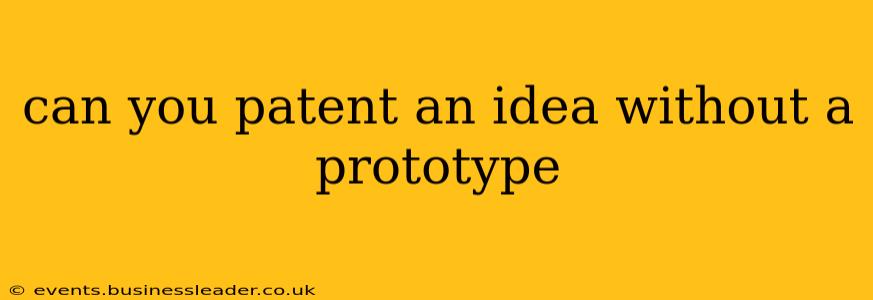Can You Patent an Idea Without a Prototype?
The short answer is: generally, no. While you can't patent a mere idea, you can patent an invention, and the key difference lies in the level of detail and demonstrable functionality. A patent protects a novel and non-obvious invention, and that invention needs to be described with sufficient clarity to allow someone skilled in the art to make and use it. This usually requires more than just a flash of inspiration; it necessitates a concrete embodiment of the invention.
Let's delve deeper into the nuances:
What is Patentable?
To be patentable, an invention must meet several criteria:
- Novelty: The invention must be new and not previously known or used by others.
- Non-obviousness: The invention must not be obvious to someone skilled in the relevant field.
- Utility: The invention must have a practical application or use.
- Enablement: The patent application must describe the invention in sufficient detail to allow someone skilled in the art to make and use it. This is where the prototype (or detailed design plans) comes in.
Why a Prototype (or Detailed Drawings) is Usually Necessary
A prototype isn't always strictly required, but it significantly strengthens a patent application. A working prototype demonstrates the invention's feasibility and functionality. Without a prototype, you'll need incredibly detailed drawings, specifications, and descriptions to fulfill the enablement requirement. The patent examiner needs to understand precisely how your invention works, its components, and its operational principles.
Imagine trying to patent a new type of engine without any diagrams or blueprints. It would be incredibly difficult, if not impossible, to convince the patent office of its novelty, non-obviousness, and utility.
What You Can Do Without a Prototype:
- File a Provisional Patent Application: This allows you to establish a priority date for your invention, giving you time to develop a prototype before filing a non-provisional application. A provisional application requires a less detailed description, but it's still crucial to describe the invention as clearly as possible.
- Focus on the Claims: The claims section of your patent application is crucial. It explicitly defines what you're claiming as your invention. Strong, well-defined claims, even without a physical prototype, can significantly improve the chances of a successful patent. However, they must be supported by the description of your invention.
- Seek Professional Help: Patent attorneys are invaluable in navigating the complexities of the patent process. They can advise you on the feasibility of patenting your idea and help you create a strong application, even without a working prototype.
H2: What if My Invention is Software?
Software patents are particularly challenging because they often deal with abstract concepts. While you don't need a physical prototype, you do need to provide detailed source code or functional specifications. This documentation needs to be comprehensive enough to show the invention’s functionality and novelty.
H2: How Much Does it Cost to Patent an Idea?
Patent costs vary significantly depending on several factors, including the complexity of the invention, the country of filing, and whether you use a patent attorney. Expect to invest considerable time and financial resources in the patent process, even for a provisional application.
H2: Can I Protect My Idea Without a Patent?
Yes, there are other options for protecting your invention, such as:
- Trade Secrets: Keeping your invention confidential can be a viable option, but it relies entirely on maintaining secrecy.
- Copyright: If your invention has an artistic or creative component, copyright protection might be applicable.
In conclusion, while you can't patent a vague idea, you can patent a well-defined invention, even without a physical prototype. However, a prototype (or detailed plans) significantly increases the likelihood of a successful patent application by providing concrete evidence of your invention's functionality and enabling a clear understanding of its structure and operation. Always seek professional legal advice from a patent attorney.
